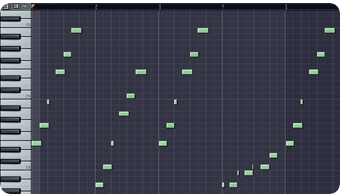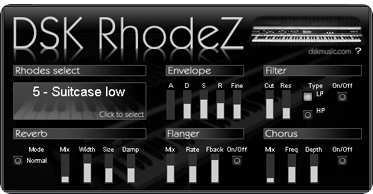Hook Composition 01
To create catchy melodies, all you have to do is play an instrument, and channel your creativity. Easy right? Sure. The hard part is paving the way for that creativity. So, how do you pave the way for that creativity and compose compelling melodies? Let’s take a look at melody composition using basic musical exercises as a starting point.
1) Build your medium: Using an instrument you’re familiar with, construct a powerful array of musical technique and theory. Through the rigorous practice of musical exercises, you’re cultivating your own medium, as it were, through which to channel your musical muse and creativity.
2) Seek inspiration: After the process of building a medium comes dedicated dawdling - playing for hours without a specific musical idea in place, yet in hopes of landing an inspiring musical riff. Whenever you play and hear something hot, you hit record. So, the dawdling is a keystone in the creative process, honing in on your improvisational skills and mastering your medium. As you stay committed to this premise, even basic
 exercises can lead to worthy hooks. To illustrate what we mean, below is a brief example of how simple musical exercises can become the launching pad of a unique, and powerful hook. Case in point: minor arpeggios. Although usually made of simple scales, arpeggios almost never tire the ear.
exercises can lead to worthy hooks. To illustrate what we mean, below is a brief example of how simple musical exercises can become the launching pad of a unique, and powerful hook. Case in point: minor arpeggios. Although usually made of simple scales, arpeggios almost never tire the ear.
 3) Bring it together: Even with a basic, limited musical vocabulary, it’s still possible to create inspiring original melodies. For example, the melody at left begins with two very simple arpeggios (an arpeggio is essentially a melody containing the notes of a chord in sequential order, from lowest to highest and back): an E minor arpeggio in the first bar, then an A minor arpeggio in the second bar, then back to E minor in the third. The fourth bar contains an A minor breakdown before it loops back to the beginning of the melody. The composer who wrote this melody could have done so immediately after learning basic minor arpeggios on the keyboard, given a little time and experimentation, and that’s exactly the point.
3) Bring it together: Even with a basic, limited musical vocabulary, it’s still possible to create inspiring original melodies. For example, the melody at left begins with two very simple arpeggios (an arpeggio is essentially a melody containing the notes of a chord in sequential order, from lowest to highest and back): an E minor arpeggio in the first bar, then an A minor arpeggio in the second bar, then back to E minor in the third. The fourth bar contains an A minor breakdown before it loops back to the beginning of the melody. The composer who wrote this melody could have done so immediately after learning basic minor arpeggios on the keyboard, given a little time and experimentation, and that’s exactly the point.
4) Fine-tune your timbre: Step 4 could just as easily be step 1, yet there are times when you’ll find yourself tweaking the timbre of a given track long into post production to make the mix sound just right. The melody in step 3 above sounds perfect using the DSK RhodeZ (http://www.dskmusic.com/blog/) free Rhodes plugin, pictured below. The timbre of a classic Rhodes keyboard is an indispensable stand-by timbre to have in your arsenal. Free plugins like this are worth their weight in gold! We’ve tweaked the original patch by adjusting the ASDR envelope and the chorus effect. So far, the hook is shaping up fine. The descending E minor to A minor sounds good, the alternating short and long notes at the beginning of the fourth bar breakdown provide a lively feel.
 Now, we’re not suggesting you simply copy this riff, and see how it sounds. In fact, it could still use a little tweaking, and we’ll show you what we have in mind in our next tip. But here is the lesson: straightforward, simple exercises can provide both a solid foundation for your chops, and broaden your musical vocabulary and improvisational skills over time, so long you stay committed. Best do what your music teacher told you!
Now, we’re not suggesting you simply copy this riff, and see how it sounds. In fact, it could still use a little tweaking, and we’ll show you what we have in mind in our next tip. But here is the lesson: straightforward, simple exercises can provide both a solid foundation for your chops, and broaden your musical vocabulary and improvisational skills over time, so long you stay committed. Best do what your music teacher told you!
Need more knowledge right now? We provide more in-depth coverage of hook composition in our Hit Theory Ebook. In addition, you can pick up valuable piano scale diagrams in our What You Know Hit Report to give you a jump start on proper keyboard finger positioning, amid a host of other production insights!







 GET 20% OFF COUPON INSTANTLY W/ SIGN-UP!
GET 20% OFF COUPON INSTANTLY W/ SIGN-UP!
 Check Out Hot Artists & Music Producers discovered through Song Submit!
Check Out Hot Artists & Music Producers discovered through Song Submit!



[…] came across this article today and found it to be extremely helpful. Especially for someone like me who has trouble creating […]
how do you tune a bassline and kick drum to the tonic ….i use FL studio DAW
hey ogyy beatpinna,
Yeah, we can tell you how we’d tune kicks with FL Studio. Maybe you’ve already figured it out though, considering there’s some pretty stupendous vids on the imageline site.
1. In the file browser at the left of FL’s DAW, you right click and select “explore”,
2. navigate to your kick sample, and drag it from the windows file that opened when you clicked “explore” into the file browser at the left of FL’s DAW
3. Now the kick sample should show up in FL’s file browser. Right click it and select the option “open in new sampler channel”
4. Within FL navigate to the new sampler channel containing your “kick”
5. Now under “time stetching” you’ll need to select “resample,” and then adjust the pitch as needed. The time-stretching algo will default to “auto,” but that’s fine. Here’s a shot of the time-stretching menu:
https://www.modernbeats.com/hit-talk/wp-content/uploads/2008/05/tipoftheday01full.jpg
Hope that helps!
- Hit Talk Staff
Hey I use Modern Beats for my instrumentals and I was wondering if you could tell me some tips on Vocal Production! I can record people but when I record, it sounds kind of hissy in the background, just like extra air or somethin, I want to know how to get rid of that! I have a condensor mic, with a boom stand and a pop-filter sittin about 2 inches away! I also use Sonic Foundry Acid Pro 4.0!
If you could help me out, that would be great!
Thank you,
TRN
aka Tron Dizzy
Cardboard Beats
I also wanted to know, I have my Sonic Foundry Acid Pro set up so when I record, it only goes on the top soundwave!? How do I turn it back!
I changed it on accident and its been like that for the past yr. or so, lol! I just dealt with it!
Also sometimes when I record someone, there voice kind of has a staticy sound on their voice, how do I get rid of that?
If you want hear a sample of my Beat and Vocal Production go here! Its my first time ever recording someone, we just messed around with a compressor, equalizer, reverb, smooth/enhance, i even tried a paragraphic equalizer but I took it out, but heres the url: Its the only song posted so no worries on searching for it! (Scarcrowz - Santoro [Produced by “Cardboard Beats”])
http://www.soundclick.com/bands/default.cfm?bandID=935614
—
The static is more dominant in the 2nd verse.
Yo TRN,
We listened to your beat. Gotta commend you on producing a finished product; quite well-done, by and large. Nice accents on the vocals, though… dig the dub delays, too.
As far as the vocal timbre - esp on second verse, as you mentioned - it sounds like your preamp is running hot… like you’ve got the gain up high and it’s distorting in the high mids, might be clipping just a little bit. The “extra air” you’re talking about might be hiss from the signal chain. We address setting up for quality vocal recording in Hit Theory…
Didn’t know what you meant at first about the “top soundwave,” but on reflection, it sounds like you might be recording one channel of the L+R channels into a stereo channel… which isn’t really a problem, but is annoying to look at. Just switch the track to mono, use whatever channel you’re recording into (left or right) as the mono input for that channel… Is that it? Let us know. Hope that helps.
peace
Good day sir, please am BJ _SAM an inspirational Artiste base in Nigeria , am finding it difficult to create a hook for my songs , please can you kindly send me some tips about on how to go about it.
Thank you sir.